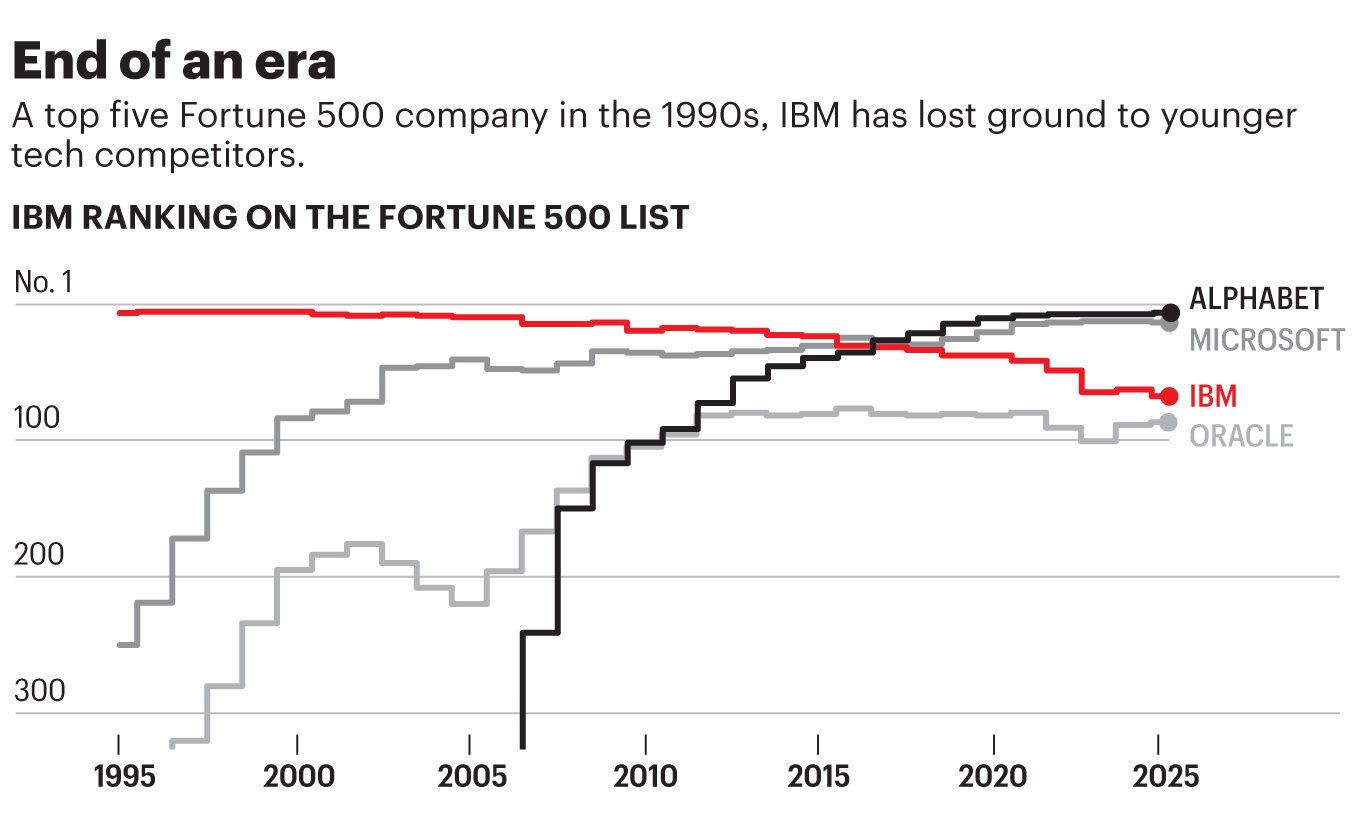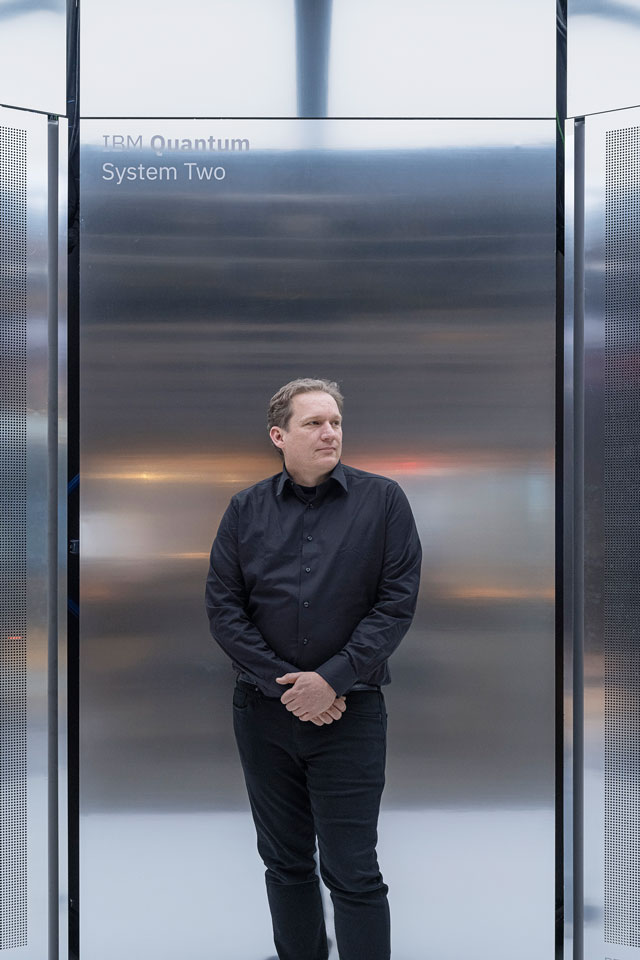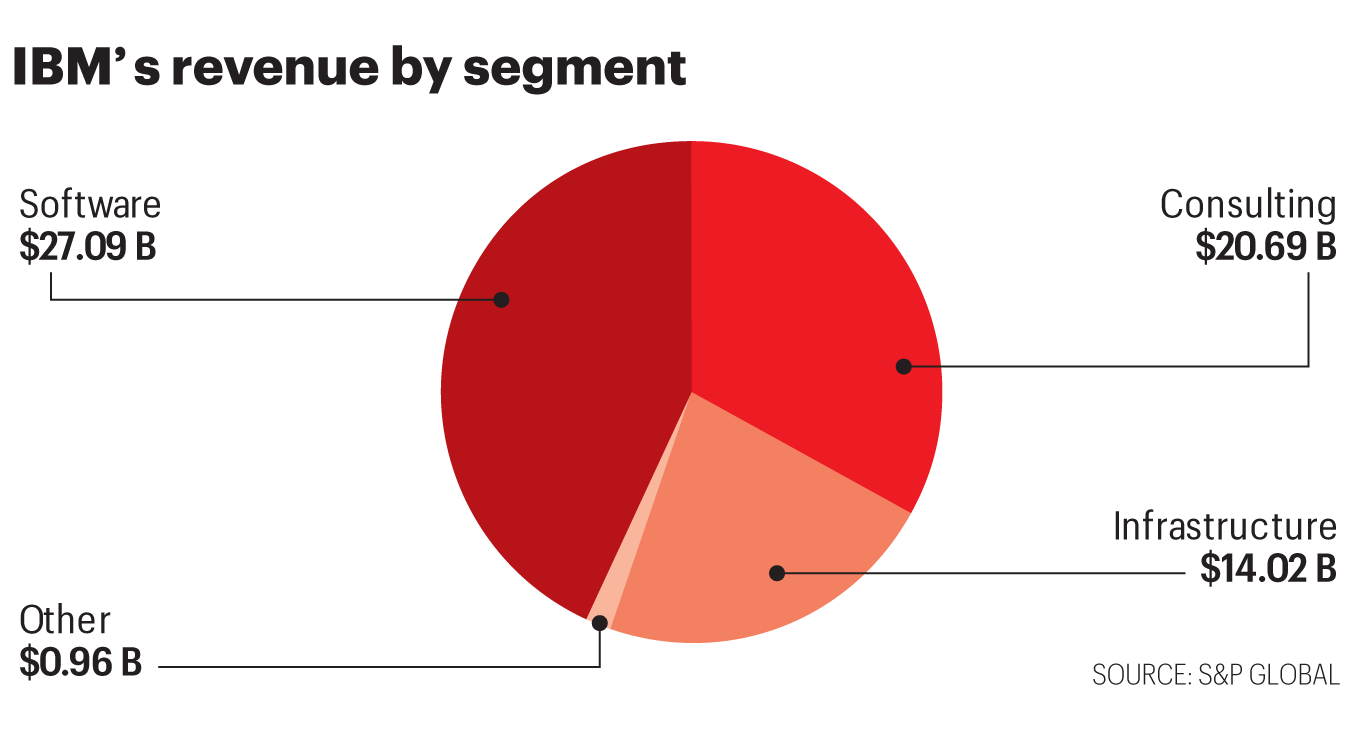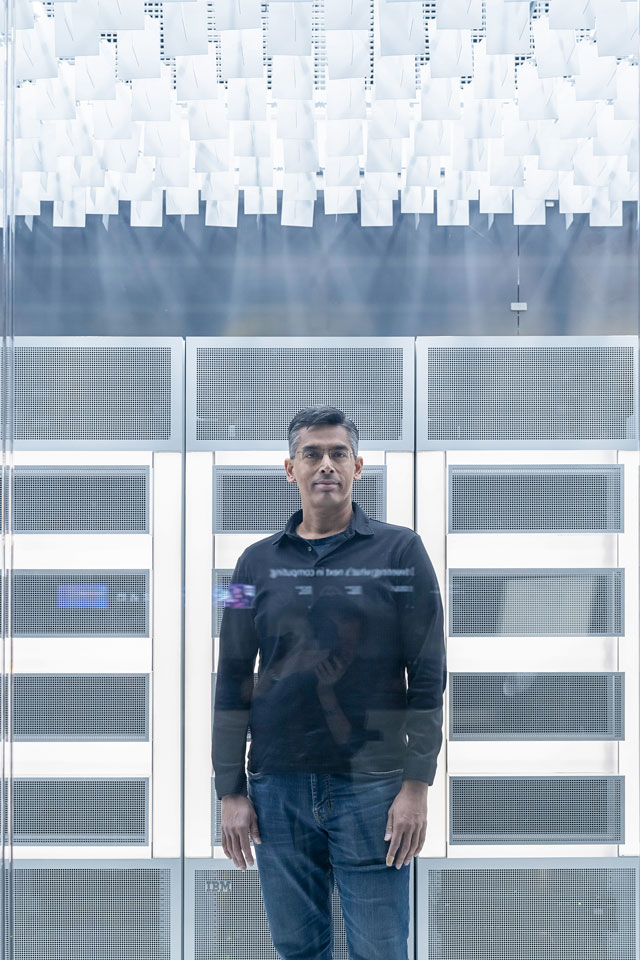The IBM Watson Research Center in Yorktown Heights, N.Y., is a midcentury modern marvel of sweeping curves and soaring glass. Designed in the early 1960s and nestled in rolling hills north of New York City, the building was the final project of the visionary architect Eero Saarinen, known for futuristic designs that captured the spirit of technological advancement, like the Gateway Arch in St. Louis and the TWA Flight Center at JFK airport.
The iconic architecture is a striking reminder of what IBM once represented: relentless innovation, industry-shaping technologies, and undisputed dominance. This was the birthplace of the punch card, the magnetic-stripe credit card, and the personal computer. It made towering mainframe computers that were indispensable to banking and health care.
But by the time CEO Arvind Krishna strode into the building in November 2021 for the company’s annual Global Technology Outlook briefing, the building was in danger of becoming a relic of corporate history—as was IBM itself.
The venerable company had barely half the revenue it generated at its 2011 high-water mark. In recent decades, it had ceded the personal computer market to Microsoft while becoming, for many, a symbol of rigid management and bloat. Even more famously, IBM had face-planted in artificial intelligence, as the much-hyped Watson platform failed to live up to its initial promise. By April 2020, when Krishna became CEO, IBM was the only one among the 17 U.S. tech companies valued at $100 billion or more to have lost market value over the previous eight years.
Krishna did not want to preserve a dusty legacy. He needed to reignite Big Blue’s drive to turn breakthrough technologies into compelling products. That’s why he listened intently at the leadership briefing as IBM’s head of AI research, Sriram Raghavan, made a presentation about a new approach to building AI: large language models pre-trained on massive datasets.

It was a full year before OpenAI would unveil ChatGPT and make generative AI famous. The presentation was dense and technical; Raghavan urged the gathered IBM executives to bear with him. But Krishna, a PhD engineer with decades of research experience, instantly recognized a game changer—and a huge opportunity. Once these models were mature enough, he realized, they would be able to help businesses handle everything from customer service to chemistry equations to climate modeling with unprecedented scale and efficiency—creating powerful new products for IBM to sell.
In a recent interview at IBM’s newly opened Manhattan headquarters, Krishna says he vividly remembers the presentation. As it unfolded, he recalls, “I’m not sure all of our business folks got it at that point.” But he could tell that the researchers and computer scientists in the room were sharing his realization: They “absolutely got where I was trying to go.”
Energized and electrified, Krishna immediately made a big bet on IBM’s future. He gave his management team the green light to steer billions in R&D money into new AI “foundation models” and the infrastructure to support them. He also pushed the company to prepare for the rise of AI by updating its hybrid cloud platform—data-storage technology that Krishna had championed as the head of IBM’s cloud division.
The pivot exemplifies the qualities that analysts and colleagues say make Krishna the right CEO at the right time. The 62-year-old is IBM’s first-ever CEO with a research and engineering background, while his 35 years at the company have helped him develop a formidable product and business acumen. As IBM works to shed its vintage image, Krishna has zeroed in on three pillars he believes are crucial to its revival: AI, cloud computing, and a bold, multi-decade bet on quantum technology.
IBM’s AI strategy today looks radically different from that of competitors like OpenAI, Meta, and Google. Rather than chasing flashy, consumer facing applications focused on massive, general-purpose language models, IBM has doubled down on the less-sexy side of generative AI.
Its flagship offering, Watsonx, is optimized for relatively niche business functions like financial services, supply-chain optimization, and IT operations, and IBM aims to embed the technology into the critical infrastructure of its corporate clients.
IBM’s recent rebound rests on two factors: A big commitment to AI and the hybrid cloud; and a faster-moving culture that emphasizes autonomy and rapid iteration.
Krishna’s innovations follow a long and often painful pivot. Over the past decade, IBM has shed headcount as it reoriented itself around new technologies. At the end of 2024 it had about 100,000 fewer employees than in 2015. It has abandoned or spun off business lines that no longer feel “core.”
But Wall Street finally likes what it sees. Since Krishna took over as CEO, the company’s share price has doubled, climbing through a string of record highs since last August. Generative AI bookings have reached $6 billion since June 2023—a meaningful sum at a company with $63 billion in annual revenue in 2024—and IBM’s increasingly streamlined software business is growing rapidly. Former IBM CEO Lou Gerstner, who famously revitalized the company in the 1990s, titled his memoir Who Says Elephants Can’t Dance? Today, some would argue that Krishna has the IBM pachyderm prancing with more agility than it has in decades.

Still, IBM hasn’t fully embraced the Silicon Valley ethos of “move fast and break things.” Compared with highly visible disrupters like Meta’s Mark Zuckerberg or OpenAI’s Sam Altman, Krishna’s approach feels more calculated and gradual. He isn’t discarding IBM’s legacy—after all, IBM has appeared on the Fortune 500 every year since the list’s debut in 1955, a testament to its resilience. But to keep it in those ranks, Krishna knows he must draft a new chapter.
For over a century, IBM’s success was shaped by an internal culture and corporate philosophy known as “the IBM Way.” It was a model of discipline and stability, exemplified by men in dark suits and skinny ties, guided by a conservative, risk-averse ethos. (Forget Silicon Valley–style microdosing: Even alcohol was banned from IBM offices until the 1980s.)
The Indian-born Krishna, who holds a PhD in electrical engineering, spent decades immersed in the IBM Way: He joined IBM Research in 1990 and served there off and on for 23 years, including five as its leader. Before taking the CEO role, he also helmed the company’s cloud computing division for a year, where he was a driving force behind IBM’s $34 billion acquisition of Red Hat. That purchase, which closed in 2019 and was the largest software deal in history at the time, positioned IBM to dominate the business of running critical software on the hybrid cloud.
But Krishna’s strategy today marks a break from the IBM Way, which historically emphasized disciplined processes, meticulous planning, and a top-down structure. Instead, he’s focused on “the Geek Way.” A self-described fan of the 2023 bestseller of that name, written by Andrew McAfee, a research scientist at MIT, Krishna often speaks about its principles, which focus on creating a fast-moving culture that emphasizes empowerment, autonomy, and evidence-based decision-making.
Krishna emphasizes the need for IBM to shed old habits and adopt a more aggressive, risk-taking ethos built on rapid iteration and constant feedback. “If you’re always going to chastise people for failing, they’re never going to try,” Krishna says. “If you tell people, ‘I’m not going to punish you if you fail, and if you need help along the way, ask for it,’ you get a lot more done with fewer people.”
Even as he seeks a more agile, nimble culture, however, Krishna is often described as a pragmatic leader. He says he’s determined not to try to be all things to all people: “[I’ll say], ‘Okay, let’s pick two things. Let’s go succeed on these before we open up a third,’ as opposed to ‘Let’s try 15 things.’” At the same time, he emphasizes that his engineering background makes him comfortable with ambitious bets: “Engineers don’t get scared about building big things,” he says.
The result has been a “dramatic evolution” of IBM’s culture, says Rob Thomas, IBM’s senior vice president of software. As an example of Krishna’s more informal style, Thomas points to his monthly “office hours,” when he gets on a webcast and takes questions from anybody in the company. At a place the size of IBM, unrehearsed CEO communications are a big deal. “It’s very relatable,” Thomas says, “and it shows the company a level of vulnerability, which is: ‘I may not have the precise answer to every question, but I’m going to give you a point of view, and then we can debate and discuss that view.’”
Walking through the IBM research center is like stepping into two worlds at once. There are the steel and glass curves of Saarinen’s design, punctuated by massive walls made of stones collected from the surrounding fields, with original Eames chairs dotting discussion nooks. But this 20th-century modernism contrasts starkly with the sleek, massive, refrigerator-like quantum computer—among the most advanced in the world—that anchors the collaboration area and working lab, where it whooshes with the steady hum of its cooling system.

Quantum is a revolutionary kind of computing, measured in qubits rather than bits, that aims to harness the quirks of quantum physics to solve incredibly complex problems far faster than even the fastest traditional computers. According to IBM’s VP of quantum, Jay Gambetta, quantum would not exist at IBM today without Krishna. In his five years as head of IBM Research, he championed its development and offered researchers freedom. “In the early days, the team required space and protection to do crazy things,” Gambetta says. “It was always Arvind who said, ‘Let them do their thing.’”
Quantum isn’t yet a meaningful contributor to IBM’s revenue. But Krishna is doubling down. Today IBM has a network of quantum computing centers and collaborations worldwide, including partnerships with multiple universities. In April, when IBM committed to $150 billion in investments in the U.S. over five years, it allocated about $30 billion to quantum tech, including mainframes to support it.
According to Liz Miller, VP and principal analyst at Constellation Research, there are only three players—IBM, Microsoft, and Google—that are within “sniffing distance” of making quantum legitimately available and impactful for large, enterprise-level companies or government research organizations. “IBM’s in it. They’re in it to win it,” Miller says.
But while quantum’s capabilities may prove to be revolutionary, IBM’s plans to develop the technology are pragmatic and gradual, with a multi-decade road map and step-bystep milestones along the way. That patience is shaped by the ghost of Watson—a technology that, in hindsight, IBM veterans think they may have pushed too fast.
The original Watson was an AI system built to understand natural language, process vast amounts of data, and provide answers—essentially, a very early version of a chatbot. It was unique tech in its time, and the platform gained national press attention when it won a $1 million prize on the quiz show Jeopardy! in 2011. Over the next few years, IBM tried to leverage those abilities by turning Watson loose on medical diagnostics and treatment recommendations—including in cancer treatment. But doctors and patients complained about inaccurate and unsafe recommendations, and the gap between the hype and the results became unignorable.
IBM eventually conceded that Watson wasn’t up to the task; the company lost billions when Watson Health was sold off for parts in 2022. Daniel Newman, an analyst and CEO of the Futurum Group, calls the original Watson “a parlor trick” and a “gimmick,” adding that since the failure, IBM has struggled to get rid of its “Watson hangover.”
Still, Miller maintains that Watson was a critical AI stepping stone. “Was it fully generative, it’s going to write a sonnet for me that sounds like Jay-Z? No. But was Watson making those if-then computations that could actually make better decisions faster than humans could make those same decisions?Absolutely it was.”
From Krishna’s point of view, a more methodical, step-by-step approach to Watson would have been preferable to New York Times headlines about curing cancer. “We took a problem that was worthy of solving, but the gaps between where we were and the problem were just way too big,” he says. It’s a mistake he hopes IBM won’t make again.
IBM’s recent results have brought mostly good news to Krishna. Its Red Hat hybrid cloud platform continues to notch double-digit percentage annual growth. IBM added more than $1 billion in AI bookings in this year’s first quarter—primarily consulting contracts for companies racing to harness the technology in business applications, just as Krishna envisioned in 2021. Its broader consulting business also remains strong, as well as ecumenical—its consultants happily help clients with other companies’ generative AI offerings, rather than locking them into IBM tools.

IBM’s progress doesn’t diminish the challenges it faces in its bid to reclaim relevance. Over the past 15 years, Big Tech got really big, while Big Blue became, for many, an afterthought. In AI, notes Newman, “IBM struggles from being IBM, in terms of breaking through and being part of those five names that everyone wants to talk about.” The competitive landscape is full of rivals closer to IBM’s size who are just as eager to help clients with more niche AI. Add a shaky economic outlook and a recent spate of canceled federal contracts, and IBM faces plenty of pressure on its bottom line.
Still, analysts and insiders take heart in the cultural shift. “In the 15 years or so that I’ve covered the company, I genuinely have not seen IBMers as optimistic about being at IBM,” Newman says. “That’s encouraging.”
Krishna remains confident that IBM will secure its place in the next era of computing if it stays focused. The heart of IBM is client-centric, not product-centric, he emphasizes: “You have to be willing to give up everything about the company except [that] fundamental premise.”
For Krishna, this isn’t just corporate philosophy; it’s engineering discipline. He recalls a freshman design class where he was told to build a bridge. Engineers learn to break down such problems, he explains: What’s going to go across the bridge? What’s the weight that has to be carried? How wide does the bridge have to be if you only have one steel beam?
That ability to deconstruct complex challenges into manageable pieces informs his leadership. “When somebody tells me we have to tackle a big task, I don’t get overwhelmed,” Krishna says. “We break it down, and those become your milestones.”
This article appears in the June/July 2025 issue of Fortune with the headline “Can AI make ‘Big Blue’ grow again?”
Evolving over the decades
IBM has pivoted multiple times over its history, but some of its more recent changes have been particularly dramatic—all in service, its leaders have said, of becoming leaner, more focused, and more relevant.
So long to the PC
IBM was the first company to put personal computers on people’s desks, and it later developed well-liked models like the ThinkPad laptop (pictured). But its traditional emphasis on “business machines” led it to underinvest in PCs and cede market share to the likes of Dell and Apple. In 2004, under then-CEO Sam Palmisano, IBM sold its PC business to China’s Lenovo.
Watson’s AI false start
The original Watson was essentially an early chatbot—able to understand natural language questions and, famously, win a Jeopardy! competition (in 2011). Subsequent attempts to commercialize the technology in health care were flops. But fans of the platform credit it with being a big stepping stone for AI—and IBM’s current generative-AI models bear the Watson name.
Laying the groundwork
Many initiatives bearing fruit under Arvind Krishna first took root under Ginni Rometty, CEO from 2012 to 2020. Rometty oversaw the awkward task of reshaping—and often, shrinking—IBM, and she presided over a steep drop in revenue. But she also backed bigger bets on AI, quantum, and the cloud, including the 2019 acquisition of Red Hat, which Krishna steered.
This article appears in the June/July 2025 issue of Fortune with the headline “Can AI make ‘Big Blue’ grow again?”
